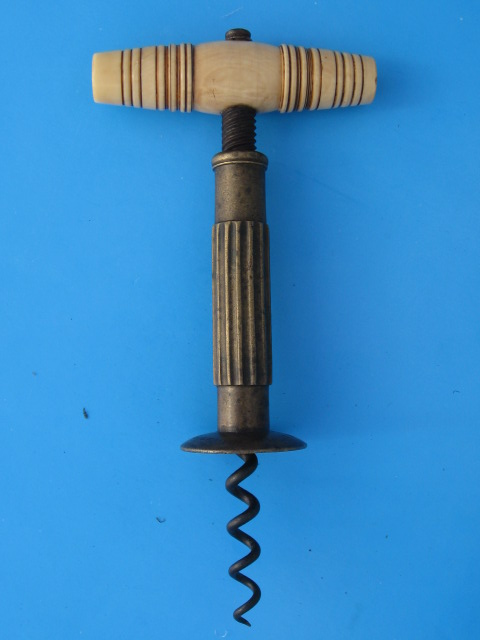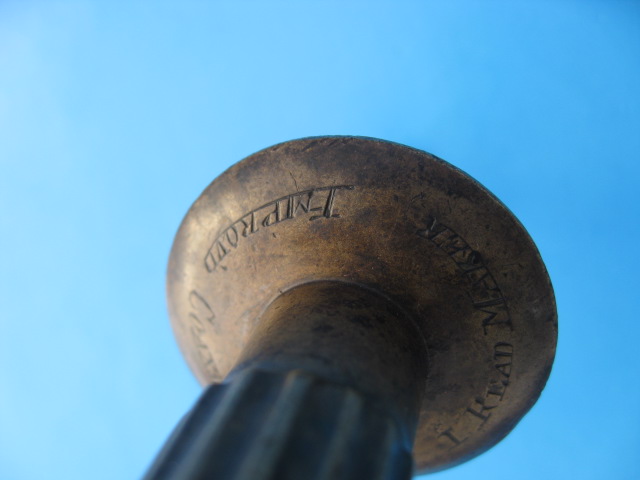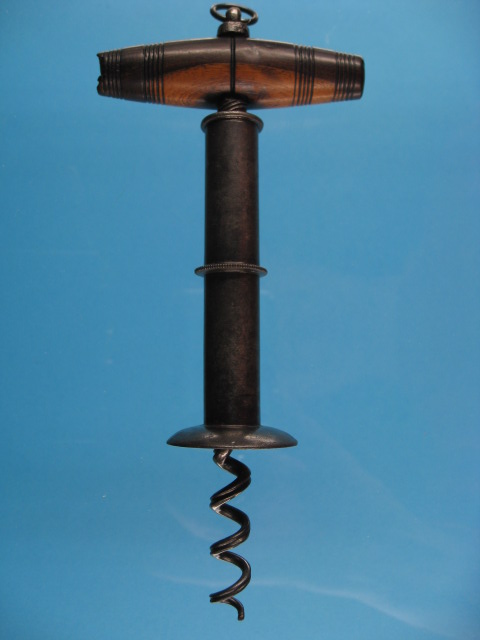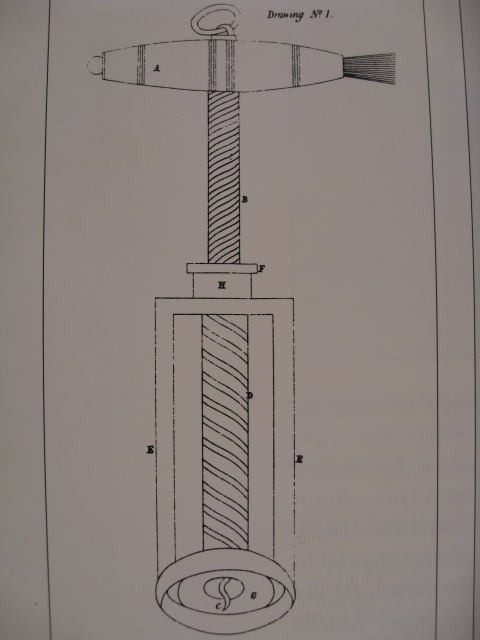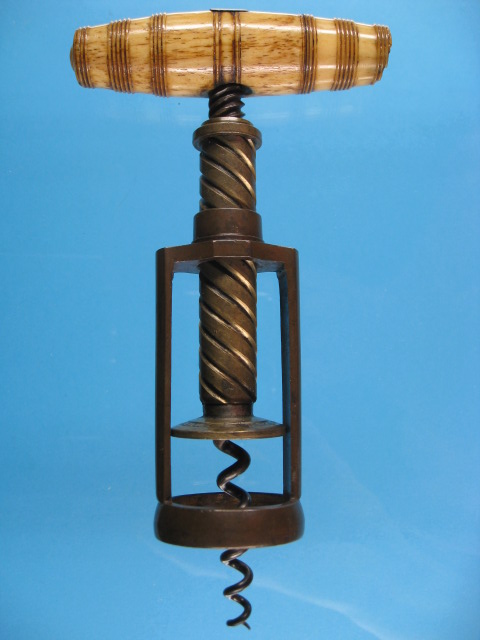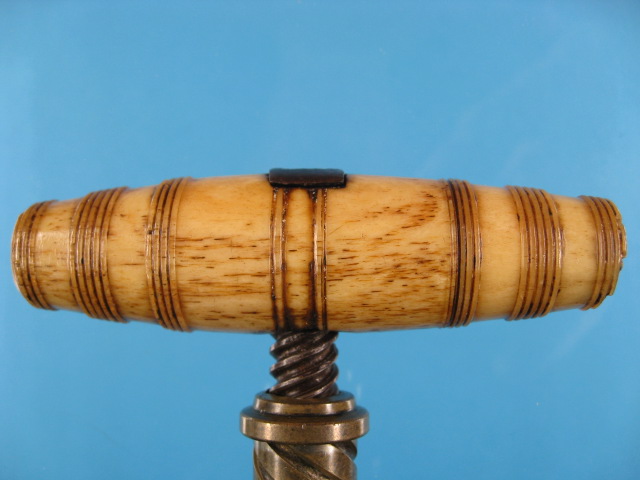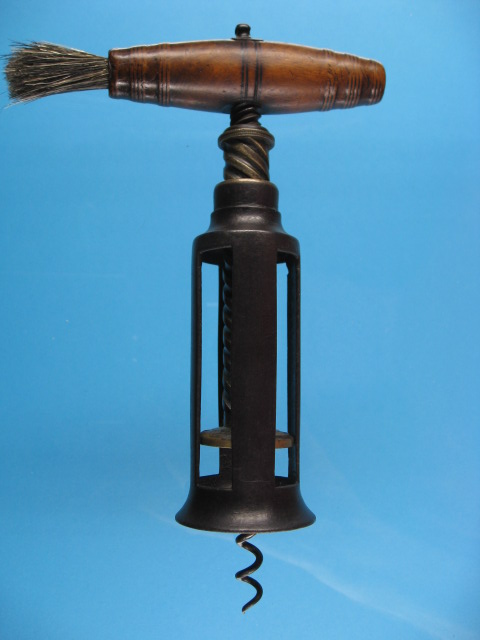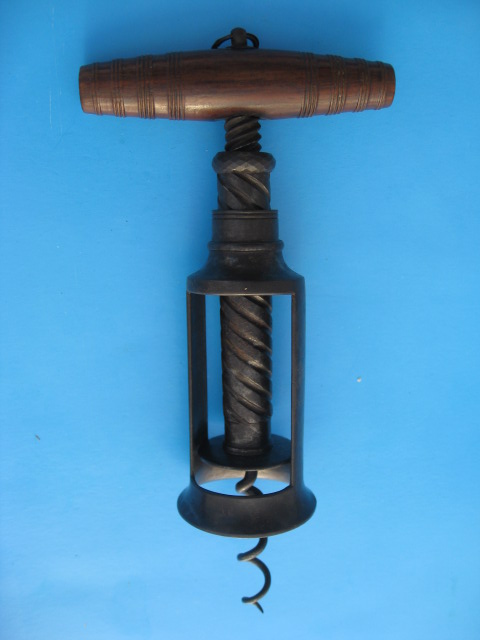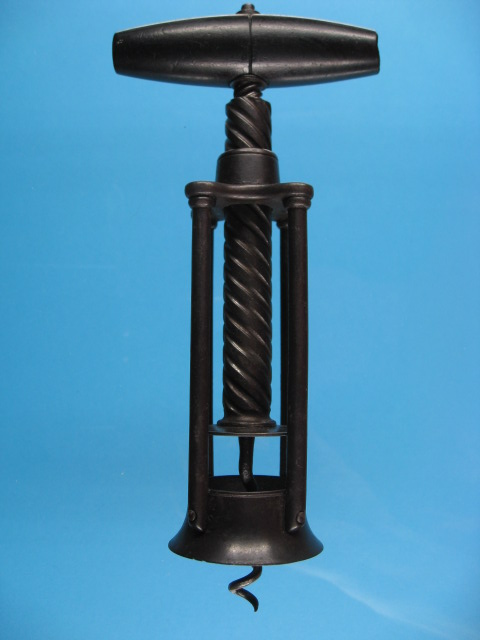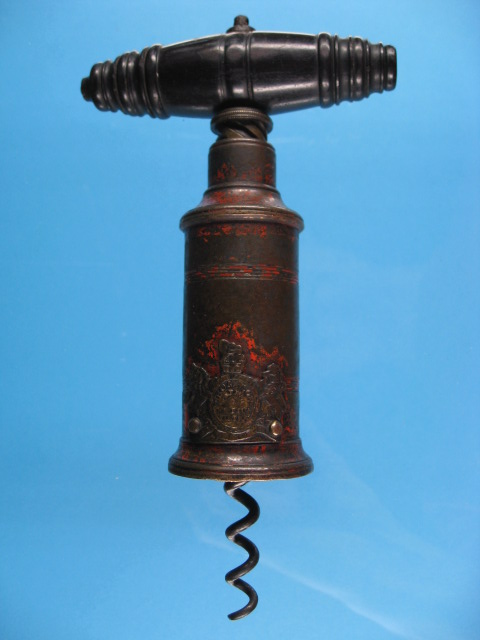Which of Edward Thomasons Corkscrews were Manufactured First??
How can we decide which of Sir Edward Thomasons corkscrews were manufactured first?
What can we focus on when trying to establish which of Thomasons corkscrews were the very earliest examples?
These are two questions that are not easy to answer. Several well known books based around corkscrews have touched on this subject, in my opinion the best of which is "Corkscrews of the Eighteenth Century-Artistry in Iron and Steel" by Bertrand B. Giulian.
In this short article I intend to try and shed some light on this topic using, reason, elimination and some opinion. I think opinion is far too often discouraged, this leads to lack of debate and often lack of progress.
Before we discuss Edward Thomasons more famous mechanical corkscrew design we need to consider another design that is generally attributed to Thomason. A mechanical corkscrew known among corkscrew collectors as "The Narrow Barrel Thomason"
Narrow Barrel Thomason Corkscrews.
I believe the corkscrew shown below, a Narrow Barrel Thomason Type could predate Thomasons 1802 Patent. Why??
This corkscrew from a private collection, interestingly is not made by Thomason, although similar examples are known made by him. This piece is the only one so far discovered and is clearly marked "THOMAS READ MAKERS" and "IMPROVED COAXER" on the concave button.
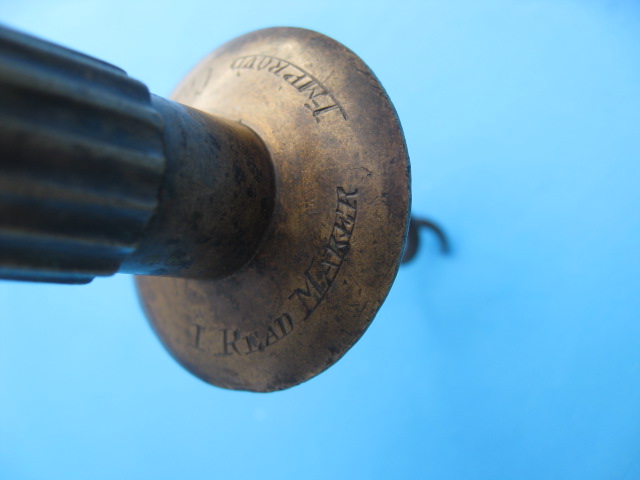
Thomas Read was a very important Irish cutler and corkscrew maker, in the late 18th century. Thomas took over his fathers business in 1776 after his fathers death. Thomas Read himself died in 1803. These dates must surely give us a clue as to the date of similar "Narrow Barrel" corkscrews made by Edward Thomason. We now know for a fact these narrow barrel pieces were in production by 1803, as Reads "Improved Coaxer" corkscrew proves this beyond doubt. Reads "Improved Coaxer" is made from bronze and steel, as are the narrow barrel corkscrews made by Thomason.
It is very possible Thomason was making "Narrow Barrel" corkscrews on or before 1803. Thomasons first mechanical corkscrews may well have been of "Narrow Barrel" design.
Below is another Narrow Barrel corkscrew, a steel example, with no makers mark. This piece has an early plain handle with tightly turned rings. It is my opinion that this piece is very early. Again we see a concave button at the bottom of the barrel.
These corkscrews are easy to operate, turning the handle simply inserts the worm into the cork. The concave button then engages the cork and continued turning causes the cork to rotate, this mechanism is similar in function to Henshalls Patent straight pull corkscrew.
EDWARD THOMASONS 1802 PATENT CORKSCREW
Using Edward Thomasons Patent application drawings can help us determine which Thomason type corkscrews were made first. Copies of these line drawings are shown below.
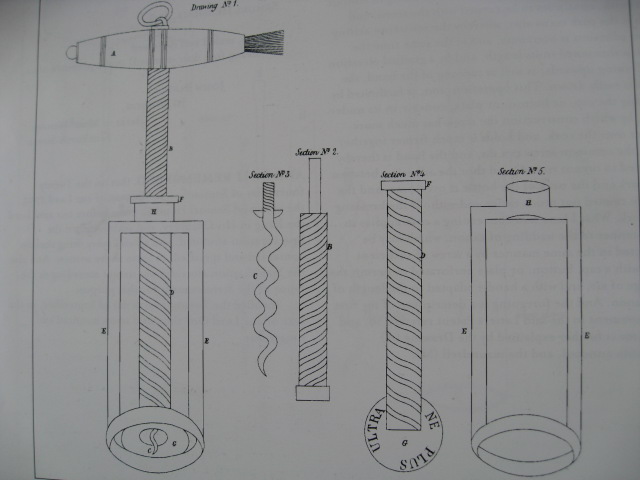
Looking carefully at the line drawings we can see particular features of an open-frame corkscrew.
I. The shape of the handle and the fact it has tight turnings.
II. The narrow bottle ring.
III. The shape and proportions of the pillars and corkscrew frame.
IV. The button is marked "Ne Plus Ultra".
When we compare the drawing to the image of the early bronze Thomason (Thomason I, open frame according to Wallis, British Corkscrew Patents from 1795) we can see immediately that all four of the above mentioned features, match up with the actual corkscrew in the above image.
The handle has tightly turned rings plus a similar shape to the handle in the drawing.
The neck ring is of similar proportion and is attached to the pillars as in the drawing.
The side pillars and top of the frame are of similar proportions to the drawing.
The button is marked "Ne Plus Ultra" as is the button in the drawings.
Therefore it stands to reason the Thomason corkscrew in the image is of the earliest type. We can take a further step and look more closely at the bronze Thomason. The handle as discussed is early, the method of fixing the handle to the shaft is interesting. A small steel square plate is inset into the top of the handle, enabling the handle to be secured to the steel shaft. The top of the steel shaft is peened over to grip the plate and provide a firm fixing. This is an early method of fixing a handle.
Below we can see the handle and its square plate.
The worm of this corkscrew is also interesting.
When you study early Thomasons they almost all seem to have this particular type of worm unless of course the worm has broken and been replaced. The worm seen here is very specific, it is very long and has multiple turns, seven in total, it tapers throughout its entire length, gradually reducing towards the centre.The worm cross section also reduces throughout its length, this is very gradual. This type of worm is very specific to early Thomasons and no other corkscrew makers used a worm exactly like this.
In his patent application Edward Thomason writes about "The Outer Skeleton Frame" this points to the early Thomason corkscrews being of open-frame construction. There are very few examples of these early bronze Thomasons as featured in existence today. This may well point to the corkscrew being of an early type.This corkscrew is robust, well made and extremely strong, it works well. I think we can conclude safely that this Thomason is of the very earliest type made by Edward Thomason.
PILLAR OR ROD THOMASON TYPE CORKSCREWS.
I think it is generally thought that some of the pillar or rod type Thomason corkscrews are also very early. Personally I don't think they are of the earliest type and here is my thinking.
Edward Thomason was the apprentice of Matthew Boulton, no doubt Boultons thoughts and ways would have been a great influence on Thomason, especially when we consider, at the young age of sixteen Thomason started working at Boultons side. Boulton was a "Social Climber" and a very showy man. We know Thomason himself was a blatant social climber both at home and on the continent. Edward Thomasons patent of 1802 according to his memoirs helped make his name. The Thomason corkscrew made him known as an inventor and it was a means of introducing other articles made in Thomason's manufacturory to his clients.
As far as I am aware there are no examples of pillar type Thomason corkscrews with Thomasons name on them, we know of II pillar, III pillar, IV pillar and VI pillar examples, all in steel. Now when we consider the type of man Thomason was and how proud he was of his corkscrew patent, surely it follows that if he had made these pillar type Thomasons he would definitely have marked them with his name or moto, "Ne plus ultra".
In my mind these steel pillar corkscrews are relatively early examples but when we consider the fact that Thomason was granted patent protection, giving him a monopoly on producing his corkscrews for a period of fourteen years, surely these pillar corkscrews must have been made after the patent protection period had subsided. Basically if my thinking is correct this means these pieces can be no earlier than 1816.
Above is a steel corkscrew manufactured by Edward Thomason, fom a private collection, this piece is probably quite early, it is marked on the button "Ne plus ultra. Thomasons Pt". It also has an early type handle with inset square plate and tightly turned rings. However the worm is not of the early type, possibly it may have been replaced. It has four steel pillars all be it wide ones.
Above is another interesting corkscrew from a private collection, it is an all steel example but is unmarked, it has two wide pillars, a narrow bottle ring which is an early feature and again it has a plain handle with tightly turned rings. There is no square plate fixing the handle but a small round plate inset into the handle.Notice the multiple facets around the inner steel shaft.
.jpg)
Above is another all steel Thomason from a private collection, the only feature of this piece that points to it being early is possibly the handle. As you can see it gets harder and harder to place these pieces chronologically.
.jpg)
.jpg)
The three pillar Thomason type corkscrews above are all steel and umarked, as discussed they probably date from 1816 onwards. Notice none of the features that we have discussed on earlier examples are seen on these three corkscrews. They have wider bottle rings and different handles plus a new method of fixing the handles.
EARLY TRADE CATALOGUES.
We can glean some information that helps us date Thomason corkscrews by looking at the early trade catalogues. There are quite a few to look at, some of which are shown in "Corkscrews of the 18th Century Artistry in Iron & Steel". The trade catalogues prior to 1820 show many mechanical corkscrews most of the examples shown have handles very similar to the handle in Thomasons patent specification drawing, this reinforces the thought that the earliest Thomasons are ones with this type of handle.
FULL OR CLOSED BARREL THOMASONS.
Interestingly none of the early trade catalogues show Thomason corkscrews with full or closed barrels, that's not to say these weren't being produced at that time. 1820 after all was four years outside the Patent protection period, in which Thomason had a monopoly to produce his invention. It is very likely these full barrel corkscrews were being manufactured during the Patent protection period.
Below is an image of a full or closed barrel Thomason, from a private collection. This piece is interesting, it has an unusual badge marked Thomason but the two bulbous pieces either side of the badge are the front of rivets, which secure the badge to the barrel. The shape of this barrel is typical of the early full barrel Thomason corkscrew, it is more than likely that Thomason used the rivet method of fixing the badges on his earlier pieces.
Those with soldered badges were most likely very slightly later. The procedure to fit a badge to the barrel using rivets would have been more expensive and more labour intensive than simply soldering a badge to the barrel. This is possibly another way we can place these Thomasons chronologically.
Look carefully at the worm of the corkscrew above, it has four turns and is broken, compare it to the bronze two pillar example earlier on in this article and it is very similar. This is an early Thomason with an early type worm, although it is broken. I have had several full barrel Thomasons of a similar design to the one above, others have had the early type handle fixed by a square plate plus the early type worm. I think those were also early full barrel examples, although the badges were soldered to the barrels not rivited.
I hope readers have enjoyed this article and it would be great to hear from some of you, questioning the information, disagreeing and telling me where I may have gone wrong. No one ever really contacts me about these articles it would be great to receive some communication.

